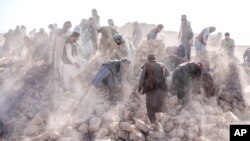Afghanistan's Taliban government Thursday lowered the death toll from a series of recent earthquakes that struck western districts to about 1,000, revising the previous figure of more than 2,000 fatalities.
The Afghan Public Health Ministry posted the latest toll on X, formerly Twitter, saying around 2,400 people had been injured since Saturday, when the first 6.3-magnitude quake rattled several districts in the western Herat province, bordering Iran.
A UNICEF spokesperson told VOA Thursday that "over 90% of those reported killed" were women and children, saying casualty "numbers are still in flux." The United Nations documented the death of around 1,300 people and nearly 1,700 injured as of Thursday. VOA reached out to U.N. officials to seek a clarification about the discrepancy but did not receive a response immediately.
Repeated aftershocks hit the Afghan disaster zone before it was shaken by another 6.3-magnitude quake Wednesday that was followed by three substantial tremors.
The latest United Nations situation report said that Wednesday's earthquake and aftershocks affected villages in the Injil, Gulran, and Kushki Robat-e-Sangi districts of Herat, injuring at least 140 people. "Chahak village in Injil district, with 1,250 residents, has been completely destroyed along with five neighboring villages," it said.
Provincial officials reported at least one death and injuries to over 150 people from the latest quake.
Siddig Ibrahim, UNICEF field officer for western Afghanistan, told VOA earlier this week that when the first earthquake hit, people thought it was an explosion and ran into their homes.
"Unfortunately, the earthquake continued, and houses started collapsing,” Ibrahim said. “Women and children are often at home, tending to the household and caring for children, so when structures collapse, they are the most at risk."
UNICEF launched a new appeal for Afghanistan on Wednesday, calling for an initial $20 million to respond to the quakes.
The World Health Organization has reported damage to 21 health facilities in 10 districts, with half caused by the October 11 tremors. So far, WHO and other agencies have provided health care services to more than 5,600 people in several highly affected districts, mainly in Zindajan, which was close to the epicenter of Saturday's quake.
Afghan hospitals, already severely underequipped and underfunded, were quickly overwhelmed. Providing shelter to quake victims on a large scale would be a challenge for the Taliban government.
"That area suffers from extreme cold, and staying outdoors for affected families after the evening is tough," Public Health Minister Qalandar Ebad told reporters Wednesday.
"They can live in tents for one month, but beyond that, it would probably be very difficult," he said.
The government has provided medicine, equipment, food, drinking water, tents, and other necessities for the victims but they still need more help, Ebad said. He praised international aid organizations for supporting his government in bringing much-needed relief goods to quake victims.
Taliban chief spokesperson Zabihullah Mujahid said that several countries had also sent relief items to displaced families in Herat.
This story has been updated to include U.N. estimates of the number of earthquake casualties.








